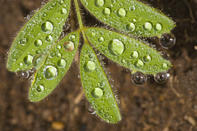Foliar feeding is a highly effective way to supply nutrients to plants. This is done by spraying soluble minerals as a fine mist on the leaves. With foliar feeding nutrients are absorbed more effectively than with soil-administered fertilizing.

Studies show between 8 and 20 times more absorption - avoiding problems sometimes encountered with root absorption like compaction of the soil, nutrient tie-ups and leaching of nutrients.
Nutrients are absorbed by the stomata. Stomata are openings in the leaves, almost like sweat glands in human skin. Stomata are also present on the stalks and stem of the plant and can absorb nutrients even in the dormant winter season when leaves have fallen off.
Most stomata occur at underside of the leaves and the best absorption time is when the plant actively grows - early growth just before flowering, at veraison (when fruit and vegetables begin to colour) and just before ripening. Foliar feeding is used to strengthen the basic fertility functions.
It encourages fruit formation, relieves plant stress when there is insect or weather related stress, prevents leaching of minerals during rain and helps with an increased resistance to insects and diseases by increasing the Brix* count. It also increases the nutritional value of the plant as indicated by studies in Pakistan on wheat.
In addition, foliar feeding together with endophytic bacteria (bacteria that grow in plant tissue without causing damage) indicated that bio-fortification of wheat by essential nutrients can help combat malnutrition. All nutrients are easily absorbed, but the mobility of minerals within the plant differs a lot.
Nitrogen (N), Phosphorus (P), Potassium (K), Copper (Cu), Manganese (Mn) and Zinc (Zn) are easily transferred to other parts of the plant, but minerals like Calcium (Ca), Magnesium (Mg), Boron (B), Iron (Fe) and Molybdenum (Mo) do not move easily.
According to Dr. De Buys Scott of the Agricultural Research Council Small Grain Institute amino acid chelated calcium is the only form of calcium that will move from the leaves down to the plant’s reproductive parts (Calcium is an important building block of cell walls and can help extend the shelflife of fruit and vegetables).
Foliar feeding is the best absorbed when sprayed as a very fine mist (under very high pressure). The smaller the droplet size, the better the absorption. The little hairs around each stomata will attract the nutrients within each drop. Use good quality water - absorption problems can be experienced with water high in sodium (Na) or ‘hard water’ (high calcium).
Add a surfactant so that the solution will stick better to the leaf. It increases absorption by preventing the water drop from forming a ‘ball’ resulting in difficulty being absorbed. The absorption is increased when the solution has a pH of between 5.5 and 6.5. Reduce the pH with apple vinegar or increase it by adding bicarbonate of soda.
The best time for spraying is between 06:00 – 08:00 in the morning or 18:00 – 20:00 at night when the humidity is high. To determine the correct solution, some farmers measure the plant’s Brix with a refractometer just before spraying and again 3 and 24 hours after spraying. The Brix can increase by up to 3 units.
*Brix (°Bx) measure the refractive index in plant juices - an indication of sugar, mineral and protein content. This may indicate that a plant is sweeter, contains more nutrients, and has lower water and nitrogen content and a better resistance to insect damage.
Bob Cantisano’s book Organic Farming: Principles and Practices gives the typical quality measurements of a few crops in Brix: Tomatoes - weak = 4°Bx and excellent = 12°Bx; Green beans - weak = 4°Bx and excellent = 10°Bx or Beetroot - weak = 2°Bx and excellent = 12°Bx.
Small farmers or balcony gardeners can make foliar feeding by using lucerne pellets (or rabbit pellets or lucerne flour). Add two cups of the pellets into 1 litre of water and leave overnight. Add this stock to 10 litres of water and spray both the bottom and top of plants. A 1% solution of EM (effective microorganisms) or earthworm compost tea may also be used as foliar nutrition.
Translated by Ananda Schoeman